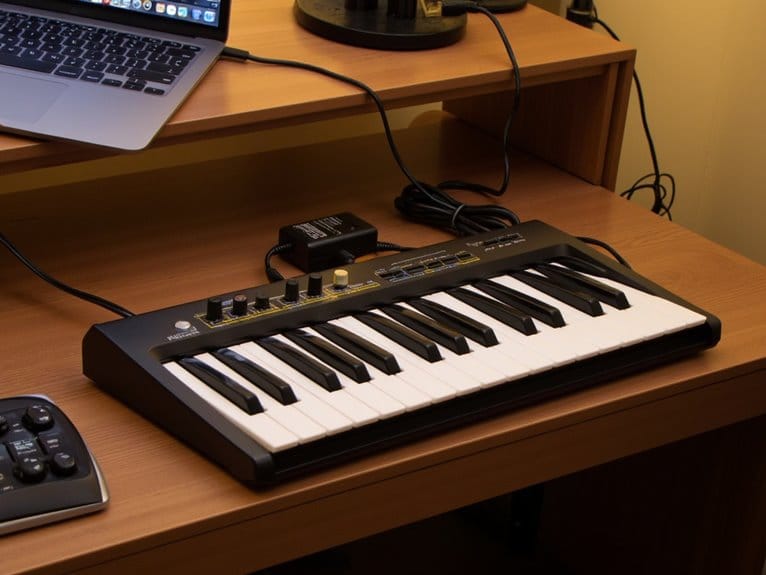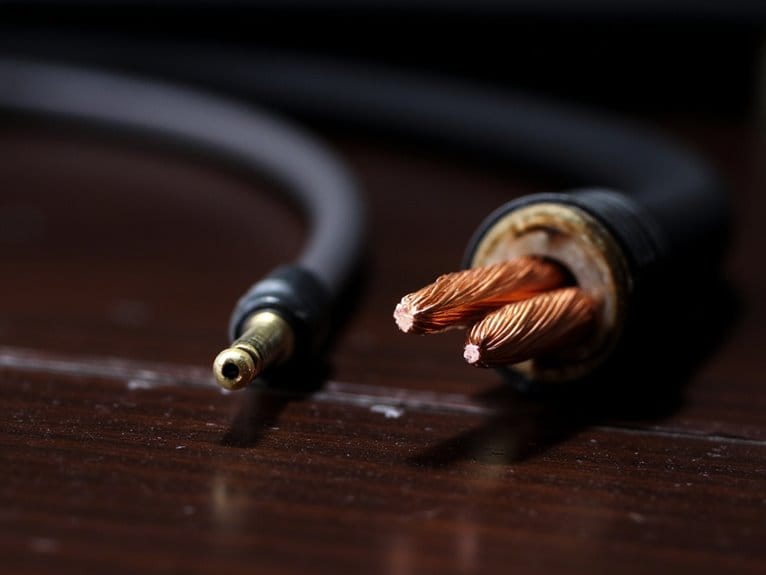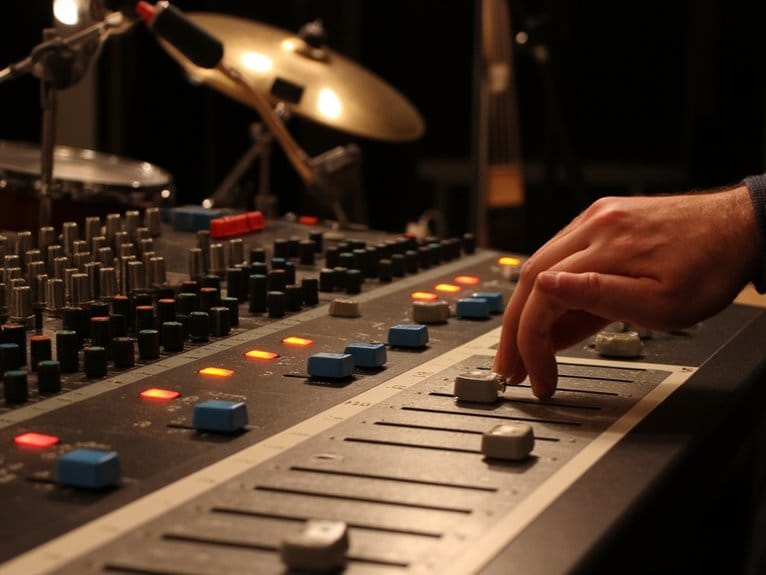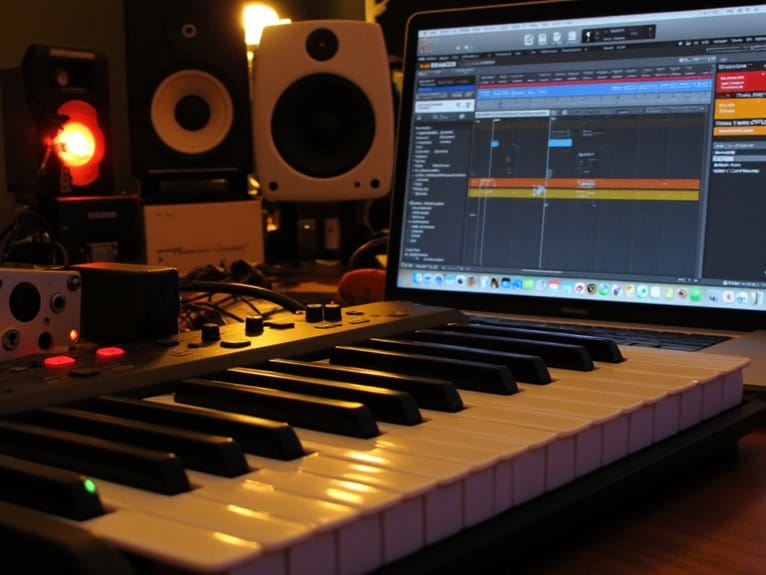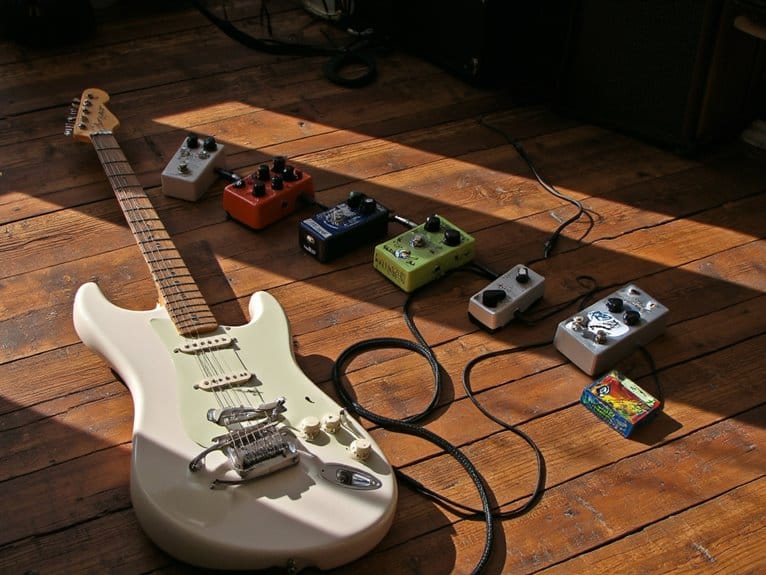Bus-Powered Vs Wall-Powered MIDI Keyboards
You’ll find that bus-powered MIDI keyboards draw power directly from your computer’s USB connection, offering simplified setup and portability, while wall-powered models require external adapters but deliver superior stability and expanded functionality. Bus-powered units excel for mobile recording and home studios due to their single-cable convenience, though they’re susceptible to power dropouts and USB limitations that cap available features. Wall-powered keyboards provide consistent performance, better audio quality, and support for advanced controls like semi-weighted keys, making them ideal for professional studios and live performances where reliability matters most. The choice ultimately depends on your specific workflow demands, budget constraints, and whether you prioritize portability over professional-grade capabilities, as each approach presents unique trade-offs that can greatly impact your music production experience.
We are supported by our audience. When you purchase through links on our site, we may earn an affiliate commission, at no extra cost for you. Learn more.
Notable Insights
- Bus-powered keyboards connect via USB for simple setup, while wall-powered models require external adapters but offer enhanced stability and features.
- USB power limitations (500-900mA) can cause performance dropouts and device resets in bus-powered keyboards during demanding recording sessions.
- Wall-powered keyboards deliver superior audio quality with cleaner signals, while bus-powered units may experience subtle hums and interference.
- Bus-powered models excel in portability for mobile setups, whereas wall-powered keyboards are preferred for professional studios and live performances.
- Bus-powered keyboards offer broader device compatibility and lower costs, while wall-powered models provide extended range capabilities up to 50 feet.
Power Source Options and Setup Requirements
When you’re choosing between bus-powered and wall-powered MIDI keyboards, understanding the fundamental differences in power delivery will save you from setup headaches and compatibility issues down the road.
Bus powered benefits include simplified connectivity through a single USB cable that handles both data transfer and power, making them ideal for portable setups and quick plug-and-play scenarios with modern DAWs. Modern USB-C connectivity reduces cable management issues and provides more reliable power delivery compared to older USB standards.
Wall powered advantages center around stability and expanded functionality, as external adapters provide consistent power for larger key counts, additional control surfaces, and legacy MIDI connections. Professional producers often prefer wall-powered models because they can accommodate semi-weighted keys with aftertouch and other advanced features that require more power. The weight difference is noticeable too, as build quality indicators like an 18+ pound weight typically reflect the durability and robust construction found in wall-powered units.
While bus-powered units excel in mobility and cable management, wall-powered keyboards offer more robust feature sets and standalone operation capabilities, though they require access to power outlets and increase setup complexity. Both options provide velocity sensitivity for dynamic playability across most modern models.
Performance Stability and Power Capacity Limitations
When you’re considering a bus-powered MIDI keyboard, you’ll quickly discover that USB power limitations can create frustrating performance bottlenecks, especially since standard USB 2.0 ports only supply 500mA while USB 3.0 maxes out at 900mA.
I’ve seen countless musicians experience unexpected device resets during critical recording sessions, where power fluctuations cause their keyboards to disconnect and reinitialize, interrupting workflow and forcing DAW synchronization delays. Even keyboards that have worked reliably for years can suddenly develop internal faults that cause them to draw excessive current and trigger power protection systems.
You’re fundamentally gambling with stability every time you connect multiple bus-powered devices to the same USB hub, as cumulative power demands can exceed capacity and trigger those dreaded “USB accessory disabled” error messages.
USB Power Limitations
Although bus-powered MIDI keyboards offer undeniable convenience through their single-cable setup, they’re fundamentally constrained by USB 2.0’s modest 2.5-watt power ceiling (5V at 500mA), which creates a cascade of performance limitations that you’ll notice during demanding musical sessions.
When you’re pushing high polyphony counts or utilizing multiple MIDI channels simultaneously, your keyboard might experience dropouts, timing irregularities, or even complete shutdowns as it struggles against these rigid power boundaries.
Despite impressive midi technology advancements in recent years, bus power compatibility remains stubbornly limited by hardware specifications that haven’t scaled with modern musical demands.
You’ll find that manufacturers often compromise on features like headphone amplifier quality, LED brightness, or onboard effects processing to squeeze within USB’s unforgiving power budget, ultimately affecting your creative workflow.
Device Reset Risks
Device resets represent one of the most frustrating aspects of working with bus-powered MIDI keyboards, creating unexpected workflow interruptions that can derail your creative momentum at the worst possible moments. You’ll find yourself unplugging devices, restarting DAWs, or rebooting entirely when your keyboard randomly disconnects from the USB bus. Wall-powered units bypass these power-related failures through dedicated external supplies, while bus-powered models remain vulnerable to insufficient current delivery.
| Power Type | Reset Frequency | Recovery Method |
|---|---|---|
| Bus-Powered | High | Full restart required |
| Wall-Powered | Moderate | Software reset sufficient |
| Hybrid Systems | Low | Automatic reconnection |
Device compatibility and driver issues compound these problems, particularly when running multiple USB devices simultaneously, creating conflicts that force your keyboard into protective reset modes regardless of available power. These power-related instabilities can be especially problematic when using USB-powered audio interfaces alongside your MIDI keyboard, as both devices compete for the same USB bus power allocation and may require additional drivers for optimal performance. Professional producers often find that compact models like 25-key controllers experience more frequent power-related resets compared to their larger counterparts due to their reliance on USB power without backup options.
Audio Quality and Electrical Interference Concerns
While I’ve tested countless MIDI keyboards over the years, I can tell you that the power source you choose greatly impacts both audio quality and electrical interference in ways that aren’t immediately obvious.
Bus-powered keyboards often struggle with audio fidelity because they’re sharing power and data lines over USB, which creates susceptibility to electrical noise and ground loops.
Wall-powered units, however, use isolated power supplies that separate power ground from USB ground, delivering cleaner signals and better electrical grounding.
Here’s what you’ll notice in real-world scenarios:
- Bus-powered setups introducing subtle hum during quiet passages
- Wall-powered keyboards maintaining pristine signal integrity under heavy loads
- Ground loop problems becoming easier to diagnose with dedicated power sources
The difference becomes especially apparent in professional studio environments where signal cleanliness matters most.
Cable Length Restrictions and Connectivity Range
Beyond audio quality concerns, you’ll find that your power choice directly affects how far you can stretch your MIDI setup, and I’ve learned this lesson the hard way after countless studio configurations that seemed perfect until I needed to move my keyboard to the other side of the room.
Bus-powered keyboards face strict USB limitations around 20 feet, where signal degradation becomes problematic, while wall-powered units can utilize traditional MIDI cables up to 50 feet before encountering MIDI cable interference issues.
| Power Type | Maximum Range | Limiting Factor |
|---|---|---|
| Bus-Powered | ~20 feet | USB power/data constraints |
| Wall-Powered | ~50 feet | MIDI signal integrity |
| With Extenders | 10+ miles | Fiber optic conversion |
| USB Hub/Active | 100+ feet | Proper signal boosting |
| Network/Wireless | Unlimited | Internet connectivity |
Consider powered USB hubs or MIDI extenders when standard cable lengths won’t accommodate your studio layout.
Professional Applications Versus Casual Use Scenarios
Your choice between bus-powered and wall-powered MIDI keyboards fundamentally depends on whether you’re building a professional workspace or setting up casual home recording, and I’ve learned that each scenario demands different priorities regarding power stability, feature requirements, and operational reliability.
Studio environments typically require the consistent performance and extended capabilities that wall-powered units provide, while live performances demand rock-solid reliability that won’t fail during critical moments when USB power fluctuations could spell disaster.
Home recording setups, however, often benefit more from the simplified connectivity and portability of bus-powered keyboards, especially when you’re just starting out or working with limited space and budget constraints. Modern setups particularly benefit when interfaces support 24-bit/192kHz resolution for capturing the highest quality MIDI and audio signals together.
Many affordable MIDI keyboards now offer plug-and-play USB connectivity that eliminates the need for additional drivers, making them particularly appealing for musicians who prioritize immediate setup and portability over maximum feature density.
Professional studios often pair MIDI keyboards with dedicated audio interfaces to ensure optimal signal quality and reduce latency issues that can compromise recording sessions.
Studio Environment Requirements
When I’m evaluating MIDI keyboards for different environments, the power source choice becomes a defining factor that separates professional studio requirements from casual home setups.
Wall-powered units deliver consistent power essential for professional studios where studio acoustics and equipment placement demand uninterrupted operation during marathon recording sessions.
Professional environments typically require:
- Stable power delivery for supporting advanced features like aftertouch, extensive control surfaces, and multiple connectivity ports
- Reliable operation during intensive multi-device MIDI data flows without risking USB power limitations or unexpected disconnects
- Integration flexibility with stationary studio racks and professional equipment that demands steady power supplies
Bus-powered keyboards excel in casual settings where portability trumps extensive functionality, though they’re limited by USB power constraints that can cause performance issues during demanding applications.
Similar power considerations apply when selecting audio interfaces, where budget-conscious users can achieve professional-grade preamps and sound quality under $200 for home studios.
Live Performance Demands
While studio environments demand consistent performance over extended periods, live performance scenarios present an entirely different set of challenges that dramatically shift the power source equation between wall-powered and bus-powered MIDI keyboards.
When you’re performing live, reliability trumps almost everything else, and wall-powered keyboards deliver the unwavering stability that professional live performance techniques require. Bus-powered units excel in portable setups where you need minimal cabling and quick teardown, but they’re vulnerable to USB power fluctuations that can cause mid-song dropouts.
I’ve learned that wall-powered controllers offer superior MIDI data handling, extensive physical controls, and integration capabilities essential for complex rigs, while bus-powered keyboards shine in acoustic venues and casual gigs where simplicity matters more than thorough control.
Home Recording Needs
In home recording environments, the power source decision between bus-powered and wall-powered MIDI keyboards hinges largely on whether you’re pursuing professional-grade productions or casual music-making. I’ve found that understanding your actual recording needs prevents both underspending on inadequate gear and overspending on features you’ll never use.
For bedroom studios with limited 15-amp circuits, bus-powered keyboards excel by consuming minimal power while maintaining essential home studio ergonomics. Wall-powered units offer stability for professional sessions but demand careful power distribution planning.
Consider these workspace acoustics factors when choosing:
- Cable management – Bus-powered units reduce clutter, improving studio flow
- Heat generation – Wall adapters add warmth, affecting room temperature
- Electrical interference – Multiple power supplies can introduce unwanted noise
Casual users benefit from bus-powered simplicity, while serious producers need wall-powered reliability. XLR connections are preferred for studio environments while USB interfaces offer convenience for home recording setups. Audio interfaces with dynamic ranges exceeding 110 dB provide the professional audio quality needed for serious home studio productions. Models like the Arturia KeyLab Essential mk3 demonstrate this balance by weighing just 8.08 pounds while delivering premium keybed experience for portable home studio setups.
Budget Considerations and Manufacturing Trade-offs
Although I’ve tested dozens of MIDI keyboards over the years, the relationship between power source and price never fails to surprise newcomers to the market.
Bus-powered keyboards deliver significant budget impact through reduced manufacturing costs, eliminating expensive transformers, power adapters, and regulation circuitry that wall-powered models require. This manufacturing efficiency translates directly to your wallet, as fewer components mean lower retail prices and reduced shipping costs from lighter packaging.
However, you’ll face trade-offs for these savings.
Bus-powered units must operate within USB’s 500mA limit, restricting power-hungry features like extensive LED arrays or high-quality preamps. Wall-powered keyboards leverage stable power for enhanced sound engines and analog circuitry, but manufacturers pass along costs for safety certifications, robust casings, and advanced shielding systems that prevent power noise issues.
Choosing the Right Power Solution for Your Workflow
How should you navigate the power choice maze when your workflow demands change faster than firmware updates? Your power management decision hinges on compatibility factors and user preferences that define your creative environment.
I’ve learned that workflow optimization starts with honest self-assessment about your setup patterns.
Consider these workflow scenarios:
- Mobile producer cramming gear into a backpack – Bus power delivers device portability without cable chaos
- Studio engineer managing multiple MIDI chains – Wall power guarantees multi device integration stability
- Weekend warrior switching between bedroom and gigs – Hybrid approach balances portable setups with reliability
Setup efficiency improves when you match power solutions to actual usage patterns, not aspirational ones.
Bus-powered keyboards excel in minimalist workflows, while wall-powered units support complex, permanent installations requiring consistent performance margins. Audio interfaces like Focusrite’s Scarlett series offer USB connectivity that ensures broad compatibility with most systems, making them ideal companions for your MIDI keyboard setup regardless of your power choice.
Frequently Asked Questions
Can I Switch Between Bus-Powered and Wall-Powered Modes on the Same Keyboard?
You can switch between power source modes on many MIDI keyboards, but it depends on your specific model. Check your manual first—switching modes typically requires unplugging one source and connecting the other.
Do Bus-Powered Keyboards Work With Tablets and Smartphones via USB Adapters?
You’ll find most bus-powered keyboards work well with tablets and smartphones using USB adapters, though you should consider compatibility concerns with device power output and potential adapter limitations affecting larger keyboards.
Do Bus-Powered Keyboards Drain Laptop Batteries Faster Than Wall-Powered Alternatives?
You’ll find bus-powered keyboards notably reduce battery efficiency since they draw power directly from your laptop’s USB port. Wall-powered alternatives eliminate this power consumption drain, preserving your laptop’s battery life during extended sessions.
On a final note
When you’re deciding between bus-powered and wall-powered MIDI keyboards, you’ll need to contemplate your studio setup, performance demands, and budget constraints. Bus-powered units offer convenience and portability but may sacrifice some features, while wall-powered models provide consistent performance with expanded capabilities. You can’t go wrong with either choice if you’ve matched the power solution to your specific workflow requirements and creative needs.

